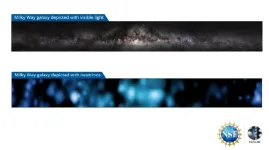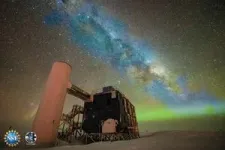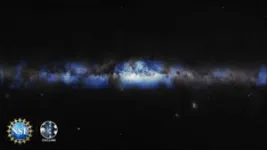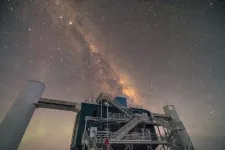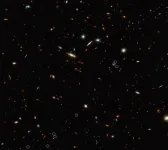(Press-News.org) From visible starlight to radio waves, the Milky Way galaxy has long been observed through the various frequencies of electromagnetic radiation it emits. Scientists have now revealed a uniquely different image of our galaxy by determining the galactic origin of thousands of neutrinos — invisible "ghost particles" which exist in great quantities but normally pass straight through Earth undetected. The neutrino-based image of the Milky Way is the first of its kind: a galactic portrait made with particles of matter rather than electromagnetic energy.
The breakthrough was achieved by a collaboration of researchers using the U.S. National Science Foundation-supported IceCube Neutrino Observatory at NSF's Amundsen–Scott South Pole Station in Antarctica. The immense observatory detects the subtle signs of high-energy neutrinos from space by using thousands of networked sensors buried deep within a cubic kilometer of clear, pristine ice. The results were revealed at an event today at Drexel University and will be published tomorrow in the journal Science.
"I remember saying, 'At this point in human history, we're the first ones to see our galaxy in anything other than light,'" says Drexel University physicist Naoko Kurahashi Neilson of the moment she and two doctoral students, Steve Sclafani with Drexel and Mirco Hünnefeld with TU Dortmund University in Germany, first examined the image. Kurahashi Neilson proposed the innovative computational analysis used to generate the image and received funding to pursue her idea through a grant from NSF's Faculty Early Career Development program.
"As is so often the case, significant breakthroughs in science are enabled by advances in technology," says Denise Caldwell, director of NSF's Physics Division. "The capabilities provided by the highly sensitive IceCube detector, coupled with new data analysis tools, have given us an entirely new view of our galaxy — one that had only been hinted at before. As these capabilities continue to be refined, we can look forward to watching this picture emerge with ever-increasing resolution, potentially revealing hidden features of our galaxy never before seen by humanity."
"What's intriguing is that, unlike the case for light of any wavelength, in neutrinos, the universe outshines the nearby sources in our own galaxy," says Francis Halzen, a physicist at the University of Wisconsin–Madison and principal investigator at IceCube.
Beyond the daunting challenge of just detecting notoriously elusive neutrinos (and distinguishing them from other sorts of interstellar particles) is the even more ambitious goal of determining where they came from. When neutrinos happen to interact with the ice beneath IceCube, those rare encounters produce faint patterns of light, which IceCube can detect. Some patterns of light are highly directional and point clearly to a particular area of the sky, allowing researchers to determine the source of the neutrinos. Such interactions were the basis for the IceCube Collaboration's 2022 discovery of neutrinos that came from another galaxy 47 million light-years away.
Other interactions are far less directional and produce cascading "fuzz balls of light" in the clear ice, says Kurahashi Neilson. Her fellow IceCube Collaboration members, Sclafani and Hünnefeld, developed a machine-learning algorithm that compared the relative position, size and energy of more than 60,000 such neutrino-generated cascades of light recorded by IceCube over 10 years.
The three researchers spent over two years meticulously testing and verifying their algorithm using artificial data simulating neutrino detections. When they eventually fed the real IceCube-provided data to the algorithm, what emerged was a picture showing bright spots corresponding to locations in the Milky Way that were suspected to emit neutrinos. Those locations were in places where observed gamma rays were thought to be the byproducts of collisions between cosmic rays and interstellar gas, which theoretically should also produce neutrinos.
"A neutrino counterpart has now been measured, thus confirming what we know about our galaxy and cosmic ray sources," says Sclafani.
Over many decades, scientists have revealed countless astronomical discoveries by expanding the methods used to observe the universe. Once-revolutionary advances such as radio astronomy and infrared astronomy have been joined by a new class of observational techniques using phenomena such as gravitational waves and now, neutrinos. Kurahashi Neilson says that the neutrino-based image of the Milky Way is yet another step in that lineage of discovery. She predicts neutrino astronomy will be honed like the methods that preceded it, until it too can reveal previously unknown aspects of the universe.
"This is why we do what we do," she says. "To see something nobody has ever seen, and to understand things we haven't understood."
END
First 'ghost particle' image of Milky Way galaxy captured by scientists
Elusive neutrinos reveal a portrait of our galaxy unlike any before
2023-06-29
ELSE PRESS RELEASES FROM THIS DATE:
How the cat nose knows what it’s smelling
2023-06-29
COLUMBUS, Ohio – Scientists have found the secret to felines’ finesse at sniffing out food, friends and foes.
A complex collection of tightly coiled bony airway structures gets the credit, according to the first detailed analysis of the domestic cat’s nasal airway.
The researchers created a 3D computer model of the cat nose and simulated how an inhalation of air containing common cat food odors would flow through the coiled structures. They found that the air separates into two flow streams, one that is cleansed and humidified and another delivering the odorant quickly and efficiently to the system responsible for ...
Gullies on Mars could have been formed by recent periods of liquid meltwater, study suggests
2023-06-29
PROVIDENCE, R.I. [Brown University] — A study led by Brown University researchers offers new insights into how water from melting ice could have played a recent role in the formation of ravine-like channels that cut down the sides of impact craters on Mars.
The study, published in Science, focuses on Martian gullies, which look eerily similar to gullies that form on Earth in the Dry Valleys of Antarctica and are caused by water erosion from melting glaciers. The researchers, including Brown planetary scientist Jim Head, built a model that simulates a sweet spot for when conditions on Mars allow the planet to warm above freezing temperatures, ...
Chemists develop new method to create chiral structures
2023-06-29
RIVERSIDE, Calif. -- Some molecules exist in two forms such that their structures and their mirror images are not superimposable, like our left and right hands. Called chirality, it is a property these molecules have due to their asymmetry. Chiral molecules tend to be optically active because of how they interact with light. Oftentimes, only one form of a chiral molecule exists in nature, for example, DNA. Interestingly, if a chiral molecule works well as a drug, its mirror image could be ineffective for therapy.
In ...
The first neutrino image of our galaxy
2023-06-29
For the first time, researchers have produced an image of the Milky Way using neutrinos, which were observed with the IceCube telescope in the Antarctic ice. The neutrino image suggests that cosmic ray interactions are more intense in the center of our galaxy than once thought. The results are published in an article in the journal Science.
For ages, the view of our Milky Way galaxy has inspired awe, visible with the naked eye as a hazy band of stars that stretches across the sky. Now IceCube researchers are able to see the Milky Way using neutrinos – tiny, ghostlike ...
DNA organization in real-time
2023-06-29
Performing cutting-edge science requires thinking outside the box and bringing together different scientific disciplines. Sometimes this even means being in the right place at the right time. For David Brückner, postdoctoral researcher and NOMIS fellow at ISTA, all the above-mentioned things came into effect as he attended an on-campus lecture by Professor Thomas Gregor from Princeton University. Inspired by the talk, Brückner reached out with an idea: to physically interpret the specific data sets Gregor presented. Now, the results of their collaboration are published ...
JDR Clinical & Translational Research receives first ever Impact Factor™
2023-06-29
Alexandria, VA – The International Association for Dental, Oral, and Craniofacial Research (IADR) and the American Association for Dental, Oral, and Craniofacial Research (AADOCR) announced today the JDR Clinical & Translational Research (JDR CTR) has received its first Journal Impact Factor™.
JDR CTR has earned a Journal Impact Factor of 3.0, with an Eigenfactor™ of 0.00148, an Immediacy Index of 0.5, and 786 total citations in 2022. This represents a significant achievement and a huge milestone in JDR CTR’s history, which was launched in 2016.
“JDR CTR’s new Impact Factor marks the culmination of years of commitment ...
Journal of Dental Research announces New Impact Factor™
2023-06-29
Alexandria, VA – The International Association for Dental, Oral, and Craniofacial Research and American Association for Dental, Oral, and Craniofacial Research announced the Journal of Dental Research (JDR) 2-Year Journal Impact Factor™ is now 7.6, ranking it #3 of 91 journals in the “Dentistry, Oral Surgery & Medicine” category.
The JDR 5-year Journal Impact Factor™ is also 7.6, with an Immediacy Index of 1.1 and an article Influence score of 1.638. The JDR once again ranked #1 of 91 journals in total citations, with a total of 25,849 in 2022, and ranked #3 in Eigenfactor with a score of 0.01345.
The 2-year Journal Impact Factor™ is defined ...
NASA’s Webb identifies the earliest strands of the cosmic web
2023-06-29
Galaxies are not scattered randomly across the universe. They gather together not only into clusters, but into vast interconnected filamentary structures with gigantic barren voids in between. This “cosmic web” started out tenuous and became more distinct over time as gravity drew matter together.
Astronomers using NASA’s James Webb Space Telescope have discovered a thread-like arrangement of 10 galaxies that existed just 830 million years after the big bang. The 3 million light-year-long structure is anchored by a luminous quasar – a galaxy with an active, supermassive black hole at ...
Improvement to CRISPR gene editing could make it more effective
2023-06-29
DURHAM, N.C. – CRISPR gene editing is a breakthrough that has been used to treat diseases such as sickle cell anemia, leukemia and genetic disorders, but it has challenges that limit its broad utility.
Identifying the root of those issues led a research team at Duke Health to find an improved approach to gene editing that expands its functionality.
In work appearing online June 29 in the journal Cell Chemical Biology, the researchers lay out a new way to identify diverse CRISPR RNA variants that can specifically home in on challenging areas of DNA to target for editing. The new approach opens up more of the genome for editing, ...
Water fasts can help you lose weight, but you might gain it back quickly
2023-06-29
Water fasts — where people consume nothing but water for several days — might help you lose weight, but it’s unclear how long you’ll keep it off, according to research from the University of Illinois Chicago. And the other metabolic benefits of water fasts, such as lower blood pressure and improved cholesterol, seem to disappear soon after the fast ends, the researchers found.
However, there do not appear to be any serious adverse effects for those who do a water fast or a similar kind of fast where people consume a very small number of calories a day, said Krista Varady, professor of kinesiology and nutrition, who led the research, ...
LAST 30 PRESS RELEASES:
New evidence challenges understanding of Parkinson’s disease
A new study reveals how embryos and the uterus “talk” during implantation
Cedars-Sinai reports heart attacks, general illness spiked after LA fires
PolyU develops ultra-stable, mucus-inspired hydrogel to boost gastrointestinal wound healing
Flour choice shapes sourdough microbial communities
Can a retinal implant reverse macular degeneration?
Feeding fungi plant remnants produces tasty protein to fortify vegan, vegetarian diets
New tech reduces false positives from breast ultrasounds
Drone-mounted lab monitors fertilizer runoff in real time
Short, light-intensity exercise boosts executive function and elevates mood in children
Jeonbuk National University researchers reveal new interface engineering strategy for efficient and stable back-contact solar cells
Tyrosinase drives hydroquinone-induced exogenous ochronosis: not HGD inhibition
UMass Amherst chemists develop unique tool for studying RNA
Disappointment alters brain chemistry and behavior
A built-in odometer: new study reveals how the brain measures distance
Stress-related brain signals drive risk of cardiovascular disease in people with depression and anxiety
New details on role of fat transport molecules in Alzheimer’s onset
Study illuminates how an antiviral defense mechanism may lead to Alzheimer’s disease
Spot the males: New gene-editing method could transform mosquito control
AI learns to build simple equations for complex systems
NAU team releases 13 years of detailed U.S. CO2 emissions data
Unveiling how sodium-ion batteries can charge faster than lithium-ion ones
How do childcare tax credits affect children’s long-term health?
Can an electronic nose detect indoor mold?
Do natural disasters have long-term impacts on mortality in older adults?
Modification improves sodium‐ion batteries as an alternative to lithium-ion batteries
Parasports provide a range of benefits for people with cerebral palsy
How does grandparental care affect children’s health?
Why are there so many Nordic mediators?
Young shark species more vulnerable to extinction
[Press-News.org] First 'ghost particle' image of Milky Way galaxy captured by scientistsElusive neutrinos reveal a portrait of our galaxy unlike any before
